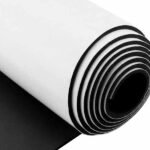Have you ever been caught in a sudden downpour or waded through a stream, only to find your boots leaking and your feet soaked? It’s a frustrating experience that can ruin your day outdoors. As someone who loves exploring the great outdoors, I understand the importance of reliable footwear that keeps your feet dry and comfortable. This is where neoprene boots come into play.
Neoprene boots are indeed waterproof, offering excellent protection against water ingress while providing comfort and flexibility for various outdoor activities.
I remember a hiking trip where unexpected rainstorms left me drenched. Luckily, I had my neoprene boots on, which kept my feet dry and warm despite the heavy downpour. This experience solidified my trust in neoprene boots as a dependable waterproof option.
What Are Neoprene Boots?
Neoprene boots are a type of footwear made from neoprene, a synthetic rubber known for its flexibility, durability, and water-resistant properties. These boots are designed to provide protection against wet conditions, making them ideal for activities such as kayaking, fishing, hiking, and other outdoor pursuits where keeping your feet dry is essential.
Neoprene boots are versatile waterproof footwear made from synthetic rubber, offering durability and flexibility for various wet and outdoor activities.
I first encountered neoprene boots during a fishing expedition. The boots not only kept my feet dry but also allowed me to move freely without feeling restricted, enhancing my overall experience on the water.
Composition and Properties
Neoprene, also known as polychloroprene, is a synthetic rubber that combines flexibility with resilience. Its closed-cell structure traps air, providing excellent insulation and buoyancy, which are critical for water-based activities. Neoprene is also resistant to oils, chemicals, and abrasion, making it a durable choice for rugged outdoor environments.
Advantages of Neoprene
| Property | Description |
|---|---|
| Flexibility | Maintains elasticity, allowing for easy movement. |
| Durability | Resistant to wear and tear, suitable for harsh conditions. |
| Insulation | Provides thermal protection by trapping air within its structure. |
| Water Resistance | Closed-cell design prevents water from penetrating. |
These properties make neoprene boots an excellent choice for individuals seeking reliable waterproof footwear that can withstand various environmental challenges.
Are Neoprene Rubber Boots Waterproof?
Yes, neoprene rubber boots are waterproof. The closed-cell structure of neoprene effectively blocks water from entering the boot, ensuring that your feet remain dry even in the wettest conditions. This inherent water resistance makes neoprene boots a popular choice for activities that involve prolonged exposure to water.
Neoprene rubber boots are inherently waterproof due to their closed-cell structure, effectively preventing water ingress and keeping your feet dry.
During a rainy day hike, my neoprene boots kept my feet dry despite walking through several puddles and muddy trails. The boots’ waterproof nature ensured that I stayed comfortable and focused on the journey rather than worrying about wet feet.
Closed-Cell Structure
Neoprene’s closed-cell foam design means that the tiny cells within the material are sealed off, preventing water from seeping through. This structure not only enhances waterproofing but also provides additional insulation by trapping air, which helps maintain foot warmth in cold conditions.
Seam Sealing
In addition to the material itself, neoprene boots often feature sealed seams. This means that the stitching areas are treated with waterproof sealants or bonded without stitching, further enhancing the boot’s ability to keep water out. Seam sealing is crucial in maintaining the waterproof integrity of the boots, especially in areas where multiple layers meet.
Waterproof Coatings
Some neoprene boots are treated with additional waterproof coatings or finishes that repel water and resist staining. These coatings can provide an extra layer of protection, ensuring that even if the outer surface of the boot becomes exposed to water, it does not penetrate the neoprene material.
Which Features Make Neoprene Boots Waterproof?
Several key features contribute to the waterproof nature of neoprene boots. These include the material’s closed-cell structure, sealed seams, waterproof coatings, and elastic closures. Together, these features ensure that water is effectively kept out, providing reliable protection for your feet in wet conditions.
The waterproofing of neoprene boots is achieved through a combination of closed-cell structure, sealed seams, waterproof coatings, and elastic closures, all working together to prevent water ingress.
I once tested these features during a kayaking trip. The closed-cell neoprene, along with the sealed seams and elastic straps, kept water out even when I leaned back into the boat, demonstrating the effectiveness of these waterproofing elements.
Closed-Cell Neoprene
The closed-cell foam design is the cornerstone of neoprene’s waterproof properties. Each cell in the foam is sealed, preventing water from passing through. This design not only blocks water but also provides buoyancy, which is beneficial for buoyancy aids and life jackets.
Sealed Seams and Bonding
Seam sealing involves applying waterproof sealants to the stitching areas or using bonded seams without traditional stitching. This prevents water from entering through the tiny gaps that stitching can create. Bonded seams are created by overlapping layers of neoprene and bonding them with heat or adhesive, ensuring a watertight seal.
Waterproof Coatings
Additional waterproof coatings can be applied to the outer surface of neoprene boots. These coatings can include silicone-based repellents or other hydrophobic treatments that make the surface water-resistant. Waterproof coatings not only enhance the material’s ability to repel water but also help protect against stains and dirt.
Elastic Closures and Adjustments
Neoprene boots often feature elastic laces, straps, or adjustable closures that create a snug fit around the ankles. This tight fit minimizes the entry points for water, ensuring that the boots remain waterproof even during dynamic movements. Elastic closures also enhance comfort by allowing the boots to stretch and conform to different foot shapes.
| Feature | Impact on Waterproofing |
|---|---|
| Closed-Cell Structure | Blocks water from penetrating the material. |
| Sealed Seams | Prevents water ingress through stitching areas. |
| Waterproof Coatings | Adds an extra barrier against water and stains. |
| Elastic Closures | Minimizes entry points for water around the ankles. |
Understanding these features helps in selecting neoprene boots that offer the best waterproof protection for your specific needs and activities.
Do Neoprene Boots Keep Your Feet Dry?
Yes, neoprene boots are designed to keep your feet dry. The combination of neoprene’s closed-cell structure, sealed seams, and waterproof coatings ensures that water does not penetrate the boots, keeping your feet dry even in the most challenging wet conditions. Additionally, the elastic closures prevent water from entering around the ankles, further enhancing the boots’ waterproof capabilities.
Neoprene boots effectively keep your feet dry by utilizing closed-cell foam, sealed seams, and waterproof coatings, ensuring comprehensive protection against water ingress.
During a kayaking adventure, my neoprene boots kept my feet completely dry despite frequent splashes and water contact. The boots’ design and materials worked together seamlessly to maintain dryness, allowing me to focus on the activity without discomfort.
Proper Fit
A well-fitted neoprene boot is crucial for maintaining dryness. Boots that are too loose can allow water to enter, while boots that are too tight may compress the neoprene, reducing its insulating and waterproofing properties. Ensuring a snug fit without restricting movement helps in maintaining the boots’ effectiveness in keeping feet dry.
Layering and Socks
While neoprene boots are designed to keep water out, wearing moisture-wicking socks can enhance dryness by drawing any residual moisture away from the skin. This combination ensures that even if a small amount of water penetrates the boots, it is quickly managed, keeping feet dry and comfortable.
Regular Maintenance
Proper maintenance of neoprene boots is essential for ensuring their continued ability to keep feet dry. Cleaning the boots regularly, checking for any signs of wear or damage, and storing them properly away from direct sunlight can help maintain their waterproof properties over time.
Design Elements
Neoprene boots often feature design elements such as high collars, reinforced soles, and gusseted openings that add extra layers of protection against water ingress. These elements work together to create a comprehensive barrier that keeps your feet dry in various wet conditions.
How Do Neoprene Boots Compare to Other Waterproof Boot Materials?
Neoprene boots offer unique advantages compared to other waterproof boot materials like Gore-Tex, rubber, and PVC. While materials like Gore-Tex provide breathable waterproofing, neoprene excels in flexibility, insulation, and durability against abrasions and chemicals. Rubber boots are also waterproof but tend to be heavier and less flexible, whereas PVC boots can be stiff and less comfortable for extended wear.
Neoprene boots outperform many other waterproof materials in terms of flexibility, insulation, and durability, making them a superior choice for active and cold-weather water activities.
I compared neoprene boots with traditional rubber boots during a long fishing trip. While both kept my feet dry, the neoprene boots were significantly more comfortable and flexible, allowing me to move effortlessly and stay warm in cold water conditions.
Neoprene vs. Gore-Tex
| Feature | Neoprene Boots | Gore-Tex Boots |
|---|---|---|
| Waterproofing | Closed-cell structure blocks water | Breathable membrane blocks water while allowing moisture to escape |
| Insulation | Excellent thermal insulation | Good insulation, but may require additional layers in very cold conditions |
| Flexibility | Highly flexible, ideal for dynamic movements | Less flexible, stiffer feel |
| Durability | Resistant to abrasions and chemicals | Durable, but can be prone to wear in harsh conditions |
| Breathability | Less breathable, can lead to sweating | Highly breathable, reducing sweat accumulation |
| Weight | Moderate, provides buoyancy | Lightweight, enhances comfort for extended wear |
Neoprene vs. Rubber
| Feature | Neoprene Boots | Rubber Boots |
|---|---|---|
| Waterproofing | Excellent, closed-cell structure | Excellent, but heavier |
| Flexibility | Highly flexible, comfortable for active use | Less flexible, can feel bulky |
| Insulation | Superior thermal insulation | Minimal to no insulation |
| Comfort | Soft and comfortable, suitable for prolonged wear | Stiff and less comfortable |
| Durability | Highly durable against abrasions and chemicals | Durable, but can crack or degrade over time |
Neoprene vs. PVC
| Feature | Neoprene Boots | PVC Boots |
|---|---|---|
| Waterproofing | Excellent, closed-cell structure | Excellent, but can be less flexible |
| Flexibility | Highly flexible, ideal for active movements | Stiff and rigid, limited flexibility |
| Comfort | Soft and comfortable | Less comfortable, can cause fatigue |
| Insulation | Superior thermal insulation | Minimal to no insulation |
| Durability | Highly durable, resistant to abrasions and chemicals | Durable, but can become brittle over time |
Advantages of Neoprene Over Other Materials
- Superior Flexibility: Neoprene allows for a full range of motion, essential for active water activities.
- Excellent Insulation: Provides better thermal protection compared to materials like rubber and PVC.
- Durability: Resistant to abrasion, chemicals, and environmental wear, ensuring longer-lasting footwear.
- Comfort: Softer and more comfortable for extended wear, reducing fatigue during prolonged activities.
By comparing these materials, it’s clear that neoprene offers a balanced combination of waterproofing, flexibility, insulation, and durability, making it a preferred choice for many outdoor and water-based activities.
What Are the Benefits of Waterproof Neoprene Boots?
Waterproof neoprene boots offer a multitude of benefits that make them an excellent choice for various water-based and outdoor activities. These benefits include superior waterproofing, thermal insulation, flexibility, durability, and comfort. Whether you’re kayaking, fishing, hiking, or working in wet environments, neoprene boots provide reliable protection and enhance your overall experience by keeping your feet dry and comfortable.
Waterproof neoprene boots provide exceptional protection against water, superior thermal insulation, high flexibility, and durability, ensuring comfort and safety in diverse wet conditions.
During a winter ice fishing trip, my neoprene boots kept my feet dry and warm, allowing me to stay focused and comfortable throughout the day. The boots’ flexibility also enabled me to maneuver easily, highlighting the practical advantages of neoprene in demanding environments.
Superior Waterproofing
Neoprene’s closed-cell structure effectively blocks water from entering the boots, ensuring that your feet remain dry even in the wettest conditions. This makes neoprene boots ideal for activities that involve prolonged exposure to water, such as kayaking, rafting, and fishing.
Thermal Insulation
Neoprene provides excellent thermal insulation by trapping air within its cells, keeping your feet warm in cold environments. This is particularly beneficial for winter sports, ice fishing, and other cold-weather activities where maintaining foot warmth is crucial.
High Flexibility and Comfort
Neoprene’s inherent flexibility allows for a comfortable fit that adapts to your foot’s movements. This flexibility ensures that the boots do not restrict your motion, making them suitable for active and dynamic activities. Additionally, the soft and elastic nature of neoprene enhances overall comfort, reducing fatigue during long hours of wear.
Durability and Longevity
Neoprene boots are highly durable, resistant to abrasions, chemicals, and environmental wear. This durability ensures that the boots can withstand the rigors of outdoor activities, providing long-lasting protection and performance.
Enhanced Grip and Stability
Many neoprene boots feature non-slip soles or textured grips that enhance traction on slippery surfaces. This added grip improves stability and safety, especially in wet and uneven terrains, reducing the risk of slips and falls.
Lightweight Design
Despite their durability and insulation properties, neoprene boots are relatively lightweight compared to other waterproof materials like rubber and PVC. This lightweight design enhances mobility and reduces the burden on your feet, making them comfortable for extended wear.
Easy Maintenance
Neoprene boots are easy to clean and maintain. They can be rinsed with fresh water after use to remove salt, dirt, and debris, ensuring that they remain in good condition and continue to provide effective waterproofing and insulation.
| Benefit | Description |
|---|---|
| Waterproofing | Keeps feet dry in wet conditions. |
| Thermal Insulation | Traps heat to keep feet warm in cold environments. |
| Flexibility | Allows for easy movement and comfort. |
| Durability | Resistant to abrasions and chemicals. |
| Grip | Non-slip soles provide better traction. |
| Lightweight | Enhances mobility and reduces fatigue. |
| Maintenance | Easy to clean and maintain for long-lasting use. |
These benefits collectively make neoprene boots a superior choice for individuals seeking reliable, comfortable, and durable waterproof footwear for a variety of outdoor and water-based activities.
Do Neoprene Boots Maintain Their Waterproofness Over Time?
Yes, neoprene boots maintain their waterproofness over time when properly cared for. The durability of neoprene, combined with its inherent water-resistant properties, ensures that the boots continue to keep your feet dry through repeated use. However, factors such as exposure to UV light, chemicals, and improper storage can impact their longevity and effectiveness. Regular maintenance and proper handling are essential to preserve the waterproof integrity of neoprene boots.
With proper care and maintenance, neoprene boots retain their waterproof properties over extended periods, ensuring continued protection and functionality.
I’ve had neoprene boots that have lasted several seasons without losing their waterproofness, thanks to consistent cleaning and proper storage. Avoiding direct sunlight and harsh chemicals has played a significant role in maintaining their effectiveness over time.
Proper Cleaning
Regular cleaning is crucial for maintaining the waterproof properties of neoprene boots. After each use, rinse the boots with fresh water to remove salt, dirt, and other contaminants. Use mild soap if necessary, and avoid harsh detergents that can degrade the neoprene material.
Storage Practices
Proper storage significantly affects the longevity of neoprene boots. Store them in a cool, dry place away from direct sunlight to prevent UV degradation. Avoid folding or crushing the boots, as this can damage the neoprene structure and compromise waterproofing.
Avoiding Harsh Chemicals
Exposure to certain chemicals can deteriorate neoprene, reducing its waterproofness. Avoid contact with oils, solvents, and other harsh substances that can break down the neoprene material. If accidental exposure occurs, clean the boots immediately to minimize damage.
Inspecting for Damage
Regularly inspect your neoprene boots for signs of wear and tear, such as tears, punctures, or seam separations. Promptly repairing any damage can prevent water ingress and maintain the boots’ waterproof integrity. Using neoprene repair kits for minor damages can extend the lifespan of your boots.
UV Protection
Prolonged exposure to UV light can weaken neoprene, making it less effective as a waterproof material. To protect your boots, store them in shaded areas and use UV-resistant sprays if necessary. Limiting sun exposure helps preserve the neoprene’s structural integrity and waterproof properties.
Reinforcement and Repairs
For added durability, consider reinforcing high-stress areas of the boots with additional neoprene patches or seam sealants. Regular maintenance and timely repairs ensure that the boots remain watertight and functional over time.
| Maintenance Aspect | Best Practices |
|---|---|
| Cleaning | Rinse with fresh water, use mild soap if needed. |
| Storage | Keep in cool, dry places away from direct sunlight. |
| Chemical Exposure | Avoid contact with oils, solvents, and harsh chemicals. |
| Inspection | Regularly check for and repair any damage. |
| UV Protection | Store in shaded areas, use UV-resistant sprays. |
| Reinforcement | Apply patches or sealants to high-stress areas. |
By adhering to these maintenance practices, you can ensure that your neoprene boots continue to provide reliable waterproofing and durability, extending their useful life and maintaining their protective qualities.
Conclusion
In conclusion, neoprene boots are indeed a highly effective waterproof footwear option, offering exceptional protection against water ingress while providing thermal insulation, flexibility, and durability. Their unique closed-cell structure, combined with features like sealed seams and waterproof coatings, ensures that your feet remain dry and comfortable in a variety of wet and outdoor conditions. Compared to other waterproof materials such as nylon, rubber, and PVC, neoprene stands out for its superior flexibility, insulation, and resistance to abrasions and chemicals, making it an ideal choice for active and cold-weather water activities.
At Szoneier, we specialize in manufacturing high-quality neoprene products, including neoprene boots, designed to meet diverse safety and comfort needs. With our 20 advanced production lines, we ensure that each pair of boots meets stringent quality standards while offering customizable options to suit your specific requirements. Our neoprene boots are durable, finely textured, soft, highly elastic, shock-resistant, thermally insulating, waterproof, and available in various designs, colors, sizes, and packaging options. We cater to B2B, wholesale, OEM, and ODM models, primarily exporting to Europe, North America, and Australia.
Whether you are a brand owner, wholesaler, importer, or design firm, Szoneier is equipped to provide you with reliable and high-quality neoprene boots that enhance safety, comfort, and brand visibility. Our low minimum order quantities and flexible customization options make it easy for you to get started. Additionally, we offer free samples and color cards to help you make informed decisions.











